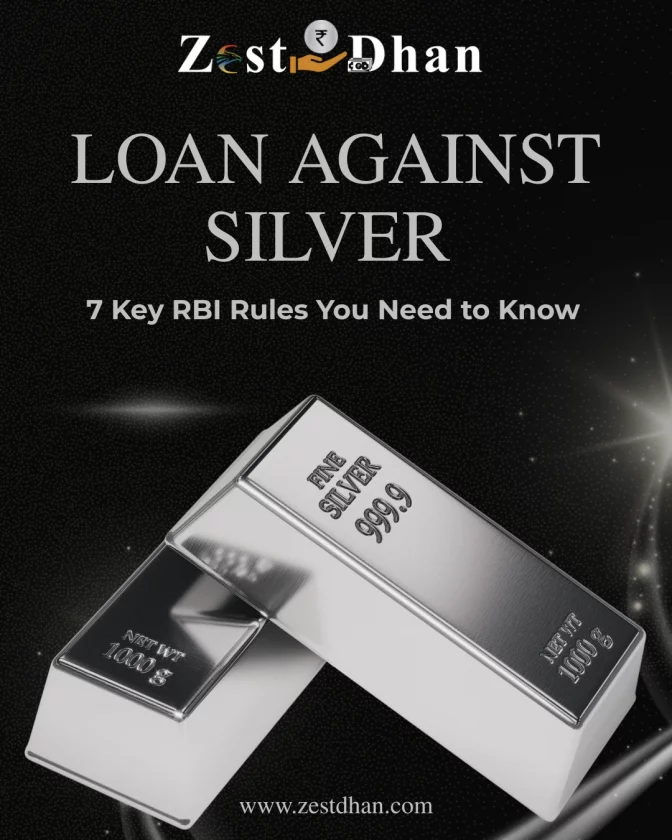Loan against silver are now officially regulated thanks to the latest RBI guidelines, giving millions of Indian households new ways to unlock the value of their silver assets. This regulatory framework not only enhances consumer confidence but also paves the way for a more structured approach to leveraging silver as a financial resource. By allowing households to use their silver holdings as collateral, the new guidelines create a bridge between traditional assets and modern financial solutions.
As a result, families can now access funds for various needs, such as education, healthcare, or starting a business, without the need to liquidate their cherished silver items. Moreover, this development is expected to stimulate the silver market, encouraging individuals to view their silver possessions not just as ornaments, but as valuable financial tools in their economic planning.
Whether you are a personal loan seeker or a fintech enthusiast, understanding the new RBI rule about loan against silver is crucial for smarter borrowing in the evolving financial landscape.

What is the New RBI Rule About Loan Against Silver?
Starting April 1, 2026, Indians can pledge up to 10 kilograms of silver ornaments and up to 500 grams of silver coins to get loans from banks, NBFCs, and housing finance firms. Silver bullion (bars) and financial products like silver ETFs cannot be used. This regulation is part of the RBI’s “Lending Against Gold and Silver Collateral Directions, 2025” moreover, it aims to standardize lending against both gold and silver for all banks and financial companies.
Why Did RBI Introduce Silver-Backed Loans?
To harmonize and standardize rules for all RBI-regulated lenders, replacing inconsistent earlier practices.
To ensure fairness, security, and transparency in asset valuation and loan management, so borrowers get rightful value and safe custody for their pledged silver.
Who Can Offer and Who Can Take Loans Against Silver?
- Commercial banks, co-operative banks, NBFCs, and housing finance firms are authorized.
- Both individual and business borrowers (including small businesses using silver in production) can avail these loans.
- The silver must be in the form of ornaments or coins and the borrower must be present for purity testing and valuation.
Key Rules and Limits for Loan Against Silver
| Item | Maximum Limit per Borrower | Maximum LTV Ratio |
|---|---|---|
| Silver Ornaments | 10 kg | Up to 85% (₹2.5 lakh), 80% (₹2.5–5 lakh), 75% (above ₹5 lakh) |
| Silver Coins | 500 grams | Same as above |
| Gold Ornaments | 1 kg | Same as above |
| Gold Coins | 50 grams | Same as above |
- The aggregate limit applies across all your loans with regulated entities.
- You cannot pledge bullion or use these loans for speculative buying or commodity trading.
How Is the Value of Silver Determined for Loans?
- The value is set as the lower of:
- The average closing price of silver (by purity) over the last 30 days in the major markets.
- The appraised value determined by certified testers at the lending institution.
- Borrowers are present during testing; all charges, auction processes, and refund timelines must be clearly disclosed in local languages.
Collateral Management and Release
- Pledged silver is kept securely; only authorized staff handle it.
- Surprise audits are mandatory to prevent fraud and ensure safe storage.
- After loan repayment, the lender must return the silver within 7 working days. Delays will lead to a ₹5,000 per day penalty for the institution.
RBI Silver Loan Limits & LTV Ratios
| Collateral Type | Max. Per Borrower | LTV Ratio (Loan Amount Slab) |
|---|---|---|
| Silver Ornaments | 10 kg | 85% (≤₹2.5L) / 80% (₹2.5–5L) / 75% (>₹5L) |
| Silver Coins | 500 gm | Same as above |
| Gold Ornaments | 1 kg | Same as above |
| Gold Coins | 50 gm | Same as above |
| Allowed Lenders | Banks, NBFCs, HFCs | Uniform norms for all |
| Not Allowed | Bullion, ETFs | Not accepted as collateral |
Steps for Borrowers to Get a Loan Against Silver
- Take your silver ornaments/coins to an authorized bank, NBFC or housing finance company.
- Undergo purity testing and valuation in-person.
- Get a detailed valuation certificate outlining loan amount, LTV, charges, and terms.
- Examine and approve the loan agreement.
- Upon repayment, receive your silver immediately or receive ₹5,000/day if repayment is exceeded by 7 working days.
Benefits of Revised Loan Against Silver Policy
- Gain value from silver assets not previously used as collateral.
- No hidden criteria, and equitable valuation, with optimized LTV limits.
- Faster access to cash for personal, business, or emergency needs.
Cons and Risks of Silver-Backed Loans
- Use limits mean high-net-worth individuals may not access large loans.
- No loans against silver bullion, impacting investors with bars or ETFs.
- Price volatility: Silver values can fluctuate, affecting loan eligibility.
Who Should Consider Loans Against Silver?
- Rural and semi-urban families with sizeable silver jewellery/coins.
- Small business owners needing quick liquidity using household silver.
- Individuals who lack gold but have silver as family savings.
Impact on Indian Borrowers
- Broadens secured loan access for millions beyond gold owners.
- Makes silver a liquid asset with easy, regulated loan access.
- Financial inclusion gets a boost, especially for women and rural households.
The Future of Silver Loans in India
The formal inclusion of silver within the collateral RBI framework is a great step as it a valuable instrument in the financial market. India’s rising silver prices in the year of 2025 projected the inclusion of silver backed loans to the market for individuals and small businesses to thrive. Banks and fintechs are in the process of adapting to new framework standards for silver collateral which may lead to new loan products and loan schemes for customers with silver backed loans.